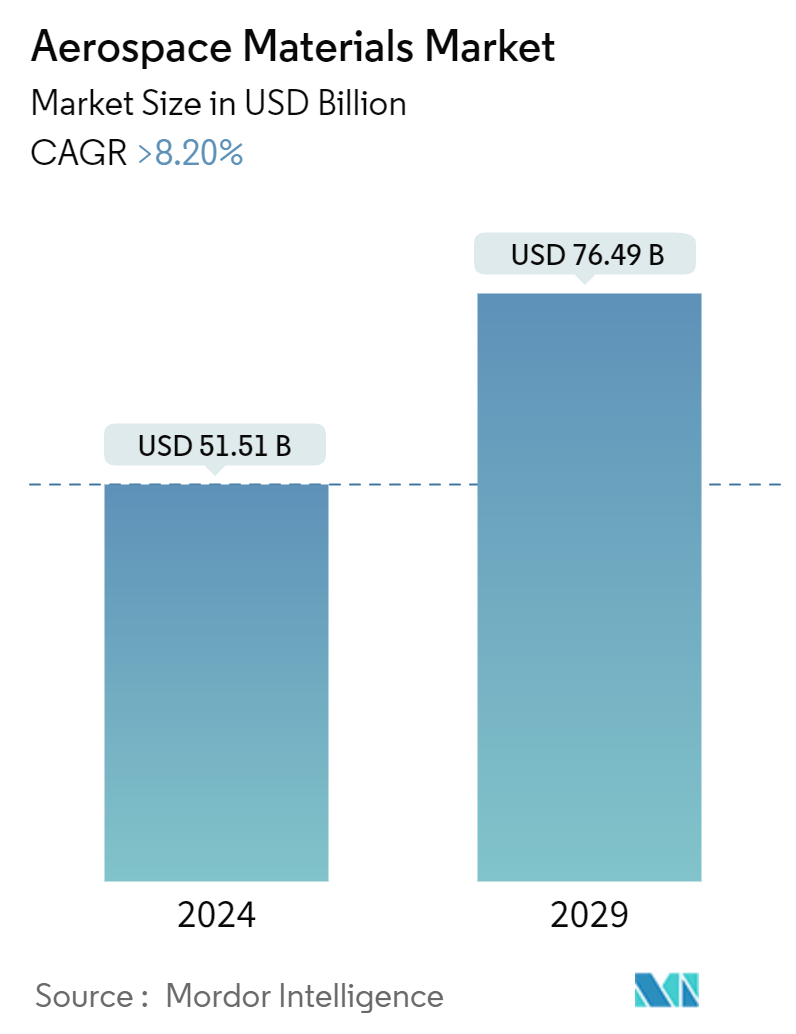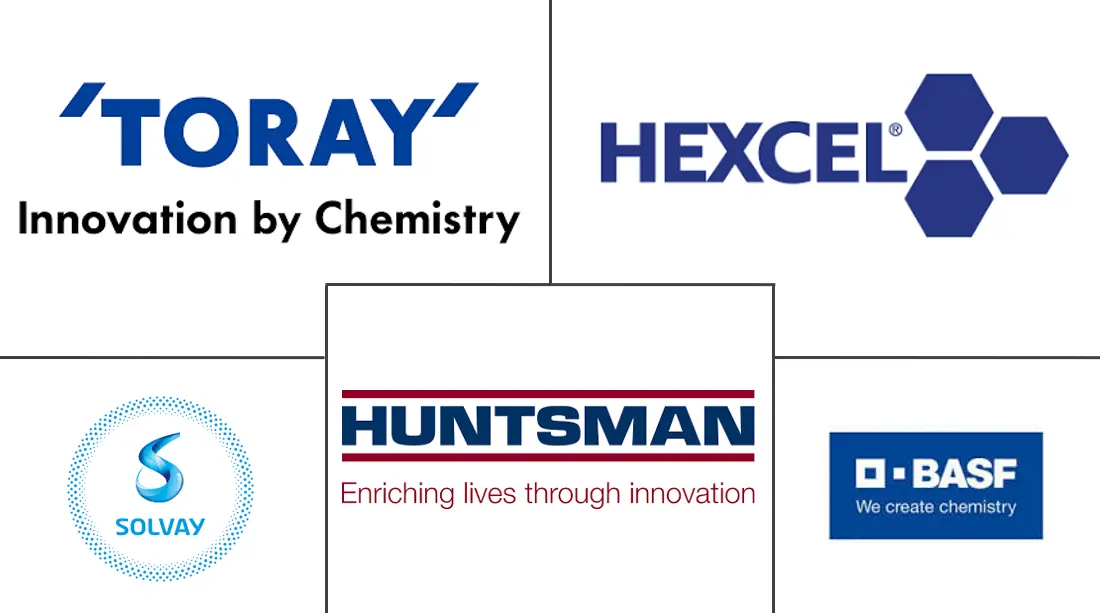Market Size of Aerospace Materials Industry

| Study Period | 2019 - 2029 |
| Market Size (2024) | USD 51.51 Billion |
| Market Size (2029) | USD 76.49 Billion |
| CAGR (2024 - 2029) | 8.20 % |
| Fastest Growing Market | Asia-Pacific |
| Largest Market | North America |
Major Players
*Disclaimer: Major Players sorted in no particular order |
Aerospace Materials Market Analysis
The Aerospace Materials Market size is estimated at USD 51.51 billion in 2024, and is expected to reach USD 76.49 billion by 2029, growing at a CAGR of greater than 8.20% during the forecast period (2024-2029).
The COVID-19 pandemic negatively impacted the market in 2020. Passenger air travel facilities were temporarily shut down because of the pandemic and the lockdowns imposed to curb the spread of the virus. However, the market showed significant growth in 2021 and is continuing to grow in recent years.
- Over the medium term, the increasing usage of composites in aircraft manufacturing, the growing space industry, and increasing government spending on defense in the United States and European countries are expected to drive the market's growth.
- On the flip side, the high manufacturing cost of carbon fibers and the declining usage of alloys are the key factors anticipated to restrain the growth of the target industry during the forecast period.
- The use of carbon nanotubes and nano-additives with epoxy adhesives is likely to create opportunities for the market in the coming years.
- North America is expected to dominate the market due to the high demand for commercial aircraft, growing government support in military spending, and expanding opportunities in the spacecraft segment.
Aerospace Materials Industry Segmentation
Aerospace materials are critical in aircraft manufacturing and must possess various characteristics such as strength and high heat resistance. The materials should be durable and have a high tolerance to damage, which is essential for fuselages. These materials are also chosen for their long lifespan and reliability, especially for fatigue resistance.
The aerospace materials market is segmented by type, aircraft type, and geography. By type, the market is segmented into structural and non-structural materials. By aircraft type, the market is segmented into general and commercial, military and defense, and space vehicles. The report also covers the market size and forecasts for the aerospace materials market in 13 countries across the region. For each segment, the market sizing and forecasts are done based on revenue (USD).
| Type | |||||||||||||||||
| |||||||||||||||||
|
| Aircraft Type | |
| General and Commercial | |
| Military and Defense | |
| Space Vehicles |
| Geography | |||||||||
| |||||||||
| |||||||||
| |||||||||
|
Aerospace Materials Market Size Summary
The aerospace materials market is poised for significant growth, driven by the increasing use of composites in aircraft manufacturing and the expanding space industry. Government investments in defense, particularly in the United States and European countries, are also contributing to this upward trend. Despite challenges such as the high manufacturing costs of carbon fibers and a decline in alloy usage, innovations like carbon nanotubes and nano-additives present new opportunities. The North American region, led by the United States, is expected to dominate the market due to its robust demand for commercial aircraft and military spending, alongside growing prospects in the spacecraft sector.
The aerospace industry is witnessing a resurgence, with a notable increase in demand for private and business travel, spurred by the rise in high-net-worth individuals globally. This demand is reflected in the procurement of advanced aircraft with enhanced features. The United States remains a leader in the aerospace sector, supported by a large fleet size and strong exports of aerospace components. Similarly, Canada's aerospace industry is a significant contributor to the economy, with substantial investments in innovation and research. The market is characterized by partial consolidation, with major players like BASF SE, Toray Industries Inc., and Hexcel Corporation actively engaging in partnerships and acquisitions to enhance their market positions and develop advanced materials.
Aerospace Materials Market Size - Table of Contents
-
1. MARKET DYNAMICS
-
1.1 Drivers
-
1.1.1 Increasing Use of Composites in Aircraft Manufacturing
-
1.1.2 Growing Space Industry
-
1.1.3 Increasing Government Spending on Defense in the United States and European Countries
-
-
1.2 Restraints
-
1.2.1 High Manufacturing Cost of Carbon Fibers
-
1.2.2 Declining Usage of Alloys
-
-
1.3 Industry Value Chain Analysis
-
1.4 Porter's Five Forces Analysis
-
1.4.1 Bargaining Power of Suppliers
-
1.4.2 Bargaining Power of Buyers
-
1.4.3 Threat of New Entrants
-
1.4.4 Threat of Substitute Products and Services
-
1.4.5 Degree of Competition
-
-
-
2. MARKET SEGMENTATION (Market Size by Value)
-
2.1 Type
-
2.1.1 Structural
-
2.1.1.1 Composites
-
2.1.1.1.1 Glass Fiber
-
2.1.1.1.2 Carbon Fiber
-
2.1.1.1.3 Aramid Fiber
-
2.1.1.1.4 Other Composites
-
-
2.1.1.2 Plastics
-
2.1.1.3 Alloys
-
2.1.1.3.1 Titanium
-
2.1.1.3.2 Aluminium
-
2.1.1.3.3 Steel
-
2.1.1.3.4 Super
-
2.1.1.3.5 Magnesium
-
2.1.1.3.6 Other Alloys
-
-
-
2.1.2 Non-structural
-
2.1.2.1 Coatings
-
2.1.2.2 Adhesives and Sealants
-
2.1.2.2.1 Epoxy
-
2.1.2.2.2 Polyurethane
-
2.1.2.2.3 Silicone
-
2.1.2.2.4 Other Adhesives and Sealants
-
-
2.1.2.3 Foams
-
2.1.2.3.1 Polyethylene
-
2.1.2.3.2 Polyurethane
-
2.1.2.3.3 Other Foams
-
-
2.1.2.4 Seals
-
-
-
2.2 Aircraft Type
-
2.2.1 General and Commercial
-
2.2.2 Military and Defense
-
2.2.3 Space Vehicles
-
-
2.3 Geography
-
2.3.1 Asia-Pacific
-
2.3.1.1 China
-
2.3.1.2 India
-
2.3.1.3 Japan
-
2.3.1.4 South Korea
-
2.3.1.5 Rest of Asia-Pacific
-
-
2.3.2 North America
-
2.3.2.1 United States
-
2.3.2.2 Canada
-
2.3.2.3 Mexico
-
-
2.3.3 Europe
-
2.3.3.1 Germany
-
2.3.3.2 United Kingdom
-
2.3.3.3 France
-
2.3.3.4 Italy
-
2.3.3.5 Spain
-
2.3.3.6 Russia
-
2.3.3.7 Rest of Europe
-
-
2.3.4 Rest of the World
-
2.3.4.1 South America
-
2.3.4.2 Middle East and Africa
-
-
-
Aerospace Materials Market Size FAQs
How big is the Aerospace Materials Market?
The Aerospace Materials Market size is expected to reach USD 51.51 billion in 2024 and grow at a CAGR of greater than 8.20% to reach USD 76.49 billion by 2029.
What is the current Aerospace Materials Market size?
In 2024, the Aerospace Materials Market size is expected to reach USD 51.51 billion.

